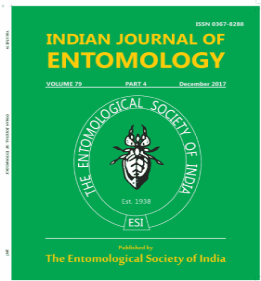Fungal Endophyte-Plant-Insect Interaction: A Tripartite Association Needing Attention
DOI:
https://doi.org/10.55446/IJE.2023.1262Keywords:
Entomopathogenic fungi, plant-feeding insects, plant microbiome, microfungi, plant performance, ecology, interactionsAbstract
Fungal endophytes are microfungi which infect the aerial and underground living tissues of plants and live within them without causing any disease symptoms. Their association with plants confers several benefits to plants and enhances their innate ability to tolerate abiotic and biotic stresses. Despite their universal occurrence, their ability to improve plant performance and capacity to produce numerous novel bioactive compounds, information on the ecology of fungal endophytes is incomplete. The interaction of these fungi with plants, plant-associated organisms, cooccurring endophytes (other fungi and bacteria), and the environment is little understood. This article highlights one such interaction among plants-fungal endophytes-plant-feeding insects that needs attention.
Downloads
Metrics
Downloads
Published
How to Cite
Issue
Section
References
Agrios G N. 1997. Plant pathology (4th ed.). Academic Press, San Diego, California.
Aly A H, Debbab A, Kjer J, Proksch P. 2010. Fungal endophytes from higher plants: a prolific source of phytochemicals and other bioactive natural products. Fungal Diversity 41: 1-16.
Arnold A E, Mejia L C, Kyllo D, Rojas E I, Maynard Z, Robbins N, Herre E A. 2003. Fungal endophytes limit pathogen damage in a tropical tree. Proceedings of the National Academy of Sciences of the United States of America 100: 15649-15654.
Bamisile B S, Dash C K, Akutse K S, Keppanan R Wang L. 2018. Fungal Endophytes: Beyond Herbivore Management. Frontiers in Microbiology 9: 544.
Bhunjun S C, Phukhamsakda C, Hyde K D, McKenzie E H C, Saxena R K, Li Q. 2023. Do all fungi have ancestors with endophytic lifestyles? Fungal Diversity. https://doi.org/10.1007/s13225-023-00516-5
Devarajan P T, Suryanarayanan T S. 2006. Evidence for the role of phytophagous insects in dispersal of non-grass fungal endophytes. Fungal Diversity 23: 111-119.
Franco F P, Túler A C, Gallan D Z, Gonçalves F G, Favaris A P, Peñaflor M F, Leal W S, Moura D S, Bento J M, Silva-Filho M C. 2021. Fungal phytopathogen modulates plant and insect responses to promote its dissemination. The ISME Journal. 15: 3522-3533.
Hyde K D, Xu J, Rapior S, Jeewon R, Lumyong S, Niego A G T, Abeywickrama P D, Aluthmuhandiram J V, Brahamanage R S, Brooks S, Chaiyasen A, Chethana K W T, Chomnunti P, Chepkirui C, Chuankid B, de Silva N I, Doilom M, Faulds C, Gentekaki E, Gopalan V, Kakumyan P, Harishchandra D, Hemachandran H, Hongsanan S, Karunarathna, A, Karunarathna, S C, Khan S, Kumla J, Jayawardena R S, Liu J-K, Liu N, Luangharn T, Macabeo A P G, Marasinghe D S, Meeks D, Mortimer P E, Mueller P, Nadir S, Nataraja K N, Nontachaiyapoom S, O’Brien M, Penkhrue W, Phukhamsakda C, Uma Shaanker R, Rathnayaka A R, Sadaba R B, Sandargo B, Samarakoon B C, Tennakoon D S, Sriprom W, Suryanarayanan T S, Sujarit K, Suwannarach N, Suwunwong T, Thongbai B, Thongklang N, Wei D, Wijesinghe S N, Winiski J, Yan J, Yasanthika E, Stadler M. 2019. The amazing potential of fungi: 50 ways we can exploit fungi industrially. Fungal Diversity 97: 1-136.
Jaber L R, Ownley B H. 2018. Can we use entomopathogenic fungi as endophytes for dual biological control of insect pests and plant pathogens? Biological Control 116: 36-45.
Koricheva J, Gange A C, Jones T. 2009. Effects of mycorrhizal fungi on insect herbivores: a meta-analysis. Ecology 90: 2088-2097.
Kusari S, Zühlke S, Spiteller M. 2009. An Endophytic Fungus from Camptotheca acuminata that produces Camptothecin and analogues. Journal of Natural Products 72: 2-7.
Kusari S, Spiteller M. 2012. Metabolomics of endophytic fungi producing associated plant secondary metabolites: progress, challenges and opportunities Roessner U (ed), Metabolomics. InTech, Rijeka, pp. 241-266.
Li T, Blande J D, Gundel P E, Helander M, Saikkonen K. 2014. Epichloë endophytes alter inducible indirect defences in host grasses. PLoS One 9:e101331.
Mantzoukas S, Eliopoulos P A. 2020. Endophytic entomopathogenic fungi: A valuable biological control tool against plant pests. Applied Sciences 10: 360.
Mejía L C, Herre E A, Sparks J P, Winter K, García M N, Van Bael S A, Stitt J, Shi Z, Zhang Y, Guiltinan M J, Maximova S N. 2014. Pervasive effects of a dominant foliar endophytic fungus on host genetic and phenotypic expression in a tropical tree. Frontiers in Microbiology 5: 479.
Mighell K, Saltonstall K, Turner B L, Espinosa-Tasón J, Van Bael S A.2019. Abiotic and biotic drivers of endosymbiont communityassembly in Jatropha curcas. Ecosphere 10:e02941.
Nagarajan A, Thirunavukkarasu N, Suryanarayanan T S, Gummadi S N. 2014. Screening and isolation of novel glutaminase free l-asparaginase from fungal endophytes. Research Journal ofMicrobiology 9: 163–176.
Raman A, Suryanarayanan T S. 2017. Fungus-plant interaction influences plant-feeding insects Fungal Ecology 29: 123-132.
Rodriguez R, Henson J, Van Volkenburgh E. et al. 2008. Stress tolerance in plants via habitat-adapted symbiosis. ISME Journal 2: 404-416.
Rodriguez R J, White Jr J F, Arnold A E, Redman A R. 2009.Fungal endophytes: diversity and functional roles. New Phytologist 182: 314-330.
Sampangi-Ramaiah M H, Jagadheesh Dey P, Jambagi S, Vasantha Kumari M M, Oelmüller R, Nataraja K N, Ravishankar K V, Ravikanth G, Uma Shaanker R.2020. An endophyte from salt-adapted Pokkali rice confers salt-tolerance to a salt-sensitive rice variety and targets a unique pattern of genes in its new host. Science Reporter 10: 3237.
Schulz B, Boyle C, Draeger S, Römmert A-K, Krohn K. 2002. Endophytic fungi: a source of novel biologically active secondary metabolites. Mycological Research 106: 996-1004.
Sengupta A, Zabala A, Tan S Y, Broadstock A, Suryanarayanan T S, Gopalan V. 2017. Characterization of an ionic liquid-tolerant β-xylosidase from a marine-derived fungal endophyte. Biochemistry and Cell Biology 95: 585-591.
Sharma S, Kooner R, Arora R. 2017. Insect pests and crop losses. In: Arora R, Sandhu S (Eds), Breeding insect resistant crops for sustainable agriculture. Springer, Singapore, pp. 45-66.
Sobhy I S, Baets D, Goelen T, Herrera-Malaver B, Bosmans L, Van den Ende W, Verstrepen K J, Wäckers F, Jacquemyn H, Lievens B. 2018. Sweet scents: nectar specialist yeasts enhance nectar attraction of a generalist aphid parasitoid without affecting survival. Frontiers in Plant Science 9: 1009.
Stierle A, Strobel G, Stierle D. 1993. Taxol and taxane production by Taxomyces andreanae, an endophytic fungus of Pacific yew. Science 260: 214-216.
Sumarah M W. Miller J D. 2009. Anti-insect secondary metabolites from fungal endophytes of conifer trees. Natural Product Communications 4: 1497-1504.
Suryanarayanan T S. 2013. Endophyte research: going beyond isolation and metabolite documentation. Fungal Ecology 6: 561-568.
Suryanarayanan T S. 2020. The need to study the holobiome for gainful uses of endophytes. Fungal Biology Reviews 34: 144-150.
Suryanarayanan T S, Uma Shaanker, R. 2021. Can fungal endophytes fast-track plant adaptations to climate change? Fungal Ecology 50: 101039.
Suryanarayanan T S, Venkatachalam A, Govinda Rajulu M B. 2011. A comparison of endophyte assemblages in transgenic and non-transgenic cotton plant tissues. Current Science 101: 1472-1474.
Suryanarayanan T S, Govinda Rajulu M B, Vidal S. 2018. Biological control through fungal endophytes: gaps in knowledge hindering success Current Biotechnology 7: 185-198.
Suryanarayanan T S, Thirunavukkarasu N, Govindarajulu M B, Sasse F, Jansen R, Murali T S. 2009. Fungal endophytes and bioprospecting. Fungal Biology Reviews 23: 9-19.
Suryanarayanan T S, Thirunavukkarasu N, Govinda Rajulu M B, Gopalan V.2012. Fungal endophytes: An untapped source of biocatalysts.Fungal Diversity 54: 19-30.
Van Bael S A, Fernández-Marín H, Valencia M C, Rojas E I, Wcislo W T, Herre E A. 2009. Two fungal symbioses collide: endophytic fungi are not welcome in leaf-cutting ant gardens. Proceedings of the Royal Society B: Biological Sciences 276:2419–2426.
Vega F E, Posada F, Aime M C, Peterson S W, Rehner S A. 2008. Fungal endophytes in green coffee seeds. Mycosystema 27: 75-84.
Vega F E. 2008. Insect pathology and fungal endophytes. Journal of Invertebrate Pathology 98: 277-279.
Wielkopolan B, Jakubowska M, Obrępalska-Stęplowska A. 2021. Beetles as Plant Pathogen Vectors. Frontiers in Plant Science. 12:748093. doi: 10.3389/fpls.2021.748093
Willsey T, Chatterton S, Cárcamo H. 2017. Interactions of root-feeding insects with fungal and oomycete plant pathogens. Frontiers in Plant Science 8: 1764. doi: 10.3389/fpls.2017.01764
















